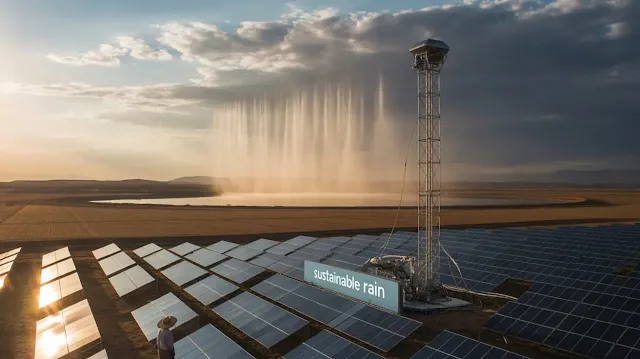Clean Energy and Artificial Rain: Can Solar Power Make It Rain?
A New Era of Weather Engineering
In a world where climate change poses real and growing threats to water security, some nations are looking upward, and not just in hope. Artificial rain, once a futuristic concept, is now becoming a viable climate intervention method, thanks to sustainable energy sources like solar power.
What Is Sustainable Cloud Seeding?
Sustainable cloud seeding is the process of using clean energy, especially solar power, to trigger the formation of rain clouds and induce precipitation. Traditional cloud seeding typically involves planes releasing substances such as silver iodide into clouds. Now, researchers and environmental engineers are looking for cleaner, more energy-efficient ways to do this, with minimal environmental impact.
How Solar Power Is Changing the Game
The integration of solar panels into cloud seeding systems marks a turning point in how we generate rain. With abundant sunlight in regions most affected by drought, solar energy provides a reliable power source for the systems used in cloud formation.
Solar-powered systems can fuel drones or weather towers equipped with ionizing technologies that encourage cloud formation by charging particles in the air. These solutions significantly reduce the carbon footprint of weather modification efforts compared to traditional fuel-based aircraft.
Case Studies: Countries Leading the Innovation
Several countries in the Middle East and Asia have begun investing in solar-powered rainmaking technologies. In the United Arab Emirates, government-backed programs are testing drone-based systems powered by renewable energy. These drones release electric charges into the atmosphere to stimulate rainfall, a technique that avoids the use of harmful chemicals.
Elsewhere, parts of Southeast Asia are exploring similar systems to support agriculture in remote regions where access to consistent rainfall is becoming increasingly rare due to changing weather patterns.
Environmental Impact and Sustainability
One of the most promising aspects of this technology is its alignment with environmental goals. By using renewable energy instead of fossil fuels, solar-powered artificial rain programs help reduce greenhouse gas emissions. Moreover, this method is less invasive than conventional seeding techniques that rely on chemical dispersal and high-fuel aircraft missions.
However, researchers emphasize the need for continued study to ensure that manipulating weather patterns doesn’t lead to unintended ecological consequences. As with all environmental technologies, responsible implementation is key.
Benefits for Agriculture and Urban Water Supply
Solar-powered artificial rain could be a game-changer for agriculture in arid zones. Crops that depend on seasonal rains could benefit from more reliable water sources, improving food security and stabilizing prices.
In urban centers, this technology may offer a sustainable way to replenish reservoirs and reduce reliance on energy-intensive desalination or water imports. By creating local rain events powered by clean energy, cities can better manage their water resources in an eco-friendly manner.
Challenges and Future Prospects
Despite its promise, solar-powered artificial rain still faces hurdles. Weather modification is a complex science, and not all regions have the atmospheric conditions required for successful seeding. Additionally, initial costs for infrastructure, including drones, ionizing towers, and solar panels, can be high.
Still, as technology advances and climate pressure increases, investment in sustainable cloud seeding is expected to grow. It offers a rare win-win scenario: mitigating drought and promoting renewable energy use in one solution.
Conclusion: Toward a Future of Renewable Weather Control
Artificial rain powered by clean energy is no longer science fiction. It’s an emerging reality driven by necessity, innovation, and sustainability. If scaled responsibly, this technology could redefine how we think about water access, especially in regions where rainfall is both precious and unpredictable.
In the coming years, expect to hear more about green weather control, and how solar panels might just be the key to opening the skies.




Write a comment, your opinion matters to us